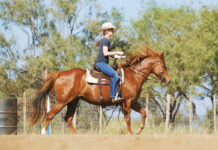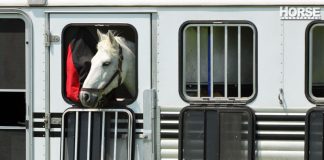
It’s always a good reminder to have a plan and be ready in case of a natural disaster or other emergency. Wildfires, floods, and hurricanes are among the most destructive disasters. If you have to evacuate your home, it’s essential to know what options you have for your animals. We hope these horse emergency planning tips help you make your plan.
The American Society for the Prevention of Cruelty to Animals (ASPCA) offers these tips for horse emergency disaster preparedness.
◆ Know where to go. You’ll need to have a few options for locations that are close enough to trailer to but far enough away that they aren’t likely to be affected by the same evacuation orders. These could includes fairgrounds or a friend or family’s property. Keep a list saved at the barn, in your car, and on your phone.
◆ If you don’t travel with your horse often, practice trailer loading at home regularly so that if you need to evacuate in an emergency, your horse will be more likely to load calmly and quickly.
◆ Know your evacuation routes and practice them ahead of time if they take you to unfamiliar roads.
◆ Network with your neighbors or other boarders at your barn. Discuss how you can pool resources, such as truck and trailer space, to get all of your horses and the necessary supplies to a safe location.
◆ Prepare an emergency kit for your horses. You’ll need a travel first-aid kit,
extra lead ropes and halters, water buckets, and enough hay and grain to get through a few days longer than you think an evacuation might last.
◆ Don’t forget planning for all your pets. Not all evacuation shelters for people allow cats and dogs.
ASPCA Disaster Response Manager Tim Perciful gives expert advice about why
you shouldn’t turn your horse loose in an emergency and the benefits of microchipping.
If evacuation of horses isn’t possible, what’s the next best option?
◆ It’s crucial to heed the warning upon any advance notice for hurricane or wildfire evacuations and try to move your horses away from danger prior to
the emergency.
◆ If you have good defensible space in a wildfire and can have a fire break, then it may be best to have your horses shelter in place. one of the challenges
to this is that wildfires can send embers over long distances, and they could still ignite a barn, pasture, fencing, et cetera.
◆ If you’re inland and on high ground, then it may be best to shelter your horses in place during a hurricane.
◆ Try to identify an evacuation barn in advance that will be available in an
emergency.
◆ One of the safest places for your animals is in an emergency animal shelter where they are out of harm’s way, have access to care, and you can check on them regularly. It may take a couple of trips to move them, so it’s important to do so prior to a mandatory evacuation notice.
Are there situations where it’s better to turn your horses loose?
◆ During a hurricane, it’s not generally advised to turn your horses loose. You should work with officials on the best thing to do for any animals that are going to be immediately impacted by a disaster. Letting your horses loose during a hurricane may keep them away from danger, but it may also make it difficult for you to be reunited with your horse unless you have proper documentation.
◆ Releasing horses that are going to be immediately impacted by a wildfire
is not usually advised. You should contact emergency personnel to see if there are any other options. Evacuating your horses as soon as possible in a disaster is crucial, and will help get your horses and your family in a safe place as soon as possible.
◆ There are times when people have to evacuate and leave their animals behind. however, it may take animal rescuers a few days to get to your animals. If you are considering this, think about food, water, medications, and the animal’s overall safety.
If you are bringing your horses to an evacuation center, what are some important things to know?
◆ Proof of vaccinations and health records are important to bring with your horse. keep your veterinary records, photos of your horse and his ID information in a Ziploc bag and ready to go at all times.
◆ Be sure your horse’s vaccinations and coggins are up to date at all times. If disaster strikes and your horse needs to be evacuated or comingled with other horses, it may restrict your ability to move him if your horse is not up to date.
Emergency IDWhat are the best ways to keep identification on horses in case they wind up loose in an emergency or you are separated during an evacuation? ◆ Microchip your horse as a permanent form of identification. It’s important to keep the microchip information up to date, especially if you have moved, or if this is a newly purchased horse that someone else microchipped. What is the process for getting a horse microchipped? ◆ Microchipping is a simple procedure that your veterinarian can perform in a couple of minutes. |
This article on horse emergency planning tips originally appeared in the September 2019 issue of Horse Illustrated magazine. Click here to subscribe!





